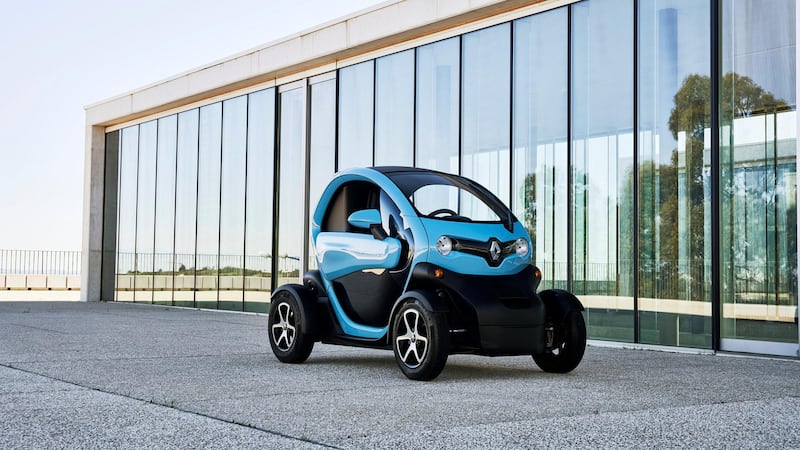If you’ve ever driven a Citroen Ami or Renault Twizy, then you’ll know what an enervating joy both cars — vehicles, if we’re being strictly correct — are. They’re a particularly French vision of low-cost, down-sized motoring, and are almost pre-war in their overall conception. Minimal size, minimal space, minimal running costs.
In general, the idea behind both these tiny two-seat electric micro-cars is not that you buy one outright and keep it yourself — although, obviously you can if that’s your desire. No, the idea is more that they can be easily parked, stacked almost, on city streets so that you can just stroll up to one, tap an app, and be on your merry way across town. With silent, emissions-free (at the point of use anyway) power and the fact that the Twizy is barely any bigger than a motorbike, and the Ami about the size of a small bathtub, they both represent an ideal form of urban, instantly available, transport.
Can that kind of vision ever come to pass in Ireland, though? And for that matter, is the vision of having lots of small, instantly available electric cars actually taking hold in the rest of Europe? The answer is mixed, and it may be more mixed still after the EU’s decision to impose less strict emissions regulations on internal combustion-engined cars. The originally proposed Euro7 rules for emissions would have made compact, petrol-engined models such as the VW Polo and Dacia Sandero uneconomic to build and sell at anything like an affordable price. The recent decision to water that down — Euro7 will now be broadly the same as Euro6 rules, albeit with a tightening of particulate emissions regulations governing tyres and brakes — may have opened a crack of survivability for small hatchbacks at reasonable prices, at least until 2035.
Does that put the mockers on the idea of teeny-tiny electric cars, especially given that they tend to cost not an awful lot less than a conventional hatchback if you’re buying privately?
Renault has not had a great deal of sales success with the Twizy, for example. Then again, it’s about the worst car for Irish conditions that you can imagine. Doors, for example, are optional and there’s no heater. Driving one, on a slow country road (the Twizy’s maximum speed is 80km/h) or around town on a sunny day is a delight. Trying to tackle a dual-carriageway in the rain is a living nightmare.
Nonetheless, there is still a charm to the Twizy, and still some prospect for success. “If you drive around in something like an Alpine sports car, or an old Porsche, you get people pointing and taking photographs, that kind of thing,” said Jeremy Warnock, product supply and distribution manager at Renault Ireland. “You get all of that with the Twizy, but it’s amplified because you have no doors nor windows, so people tend to strike up a conversation with you. Mind you, that probably wouldn’t be the case if quadricycles were more prevalent here.”
A fair point — people flock around a Twizy or an Ami because such a thing is rare. Equally, the phrase “Quadricycle” throws up a potential spanner in the Irish works. Other European countries — France especially — have particular laws and regulations for these cars that aren’t quite cars. You can drive them from as young as 14 for example, while insurance and tax costs are trifling.
That is not the case here in Ireland. According to Insurance Ireland, right now there’s no special category for such a vehicle. “While motor insurance for larger EVs is available in the market, we are not aware of any standard motor insurance products that are currently available for some of the bespoke small electric microcars that have been developed as insurers here may not be familiar with the classification of these vehicles and they would currently fall outside mainstream pricing and underwriting criteria,” a spokesperson for Insurance Ireland told The Irish Times. “If you are considering purchasing a small electric microcar it would be worthwhile to contact a broker or insurer beforehand for a quote. Regarding the offering of discounts, pricing is a matter for each individual insurer to assess relative to their particular commercial strategy, risk appetite and historical claims experience. When it comes [to] permission for younger drivers being allowed to drive such vehicles such as the age of 14 in France, it would be a matter for the licensing authorities to decide this element as part of an overall regulatory regime covering licensing, training testing, etc.”

As far as the Department of Transport is concerned, such vehicles as the Ami and Twizy fall into the same Category A as motorbikes, and the department further notes that because the Ami has a top speed of 45km/h, you’re not allowed to drive it on motorways — technically you can with a Twizy, and this author has done so, but can’t recommend it. A Scania looks really, really big when it’s whipping past your right ear, horns blaring angrily.
Nonetheless, Citroen keeps bringing the Ami here in numbers. So far, only a few individual Amis have been brought in for testing and media drives, but Citroen Ireland’s managing director Colin Sheridan told The Irish Times that only a few hurdles need yet to be jumped to start selling the model here properly. “We’re in discussions with the insurance industry to get a rating, and once we can get that we’ll be able to gather quotations,” said Sheridan. “We had the car at the Bloom festival, and we received a lot of interest in it from the crowds there. There’s a lot of interest from older people, who are maybe looking to down-size out of a larger car, and there’s equally interest from people who have a large car right now, and want something for just nipping in and out of town.”
All of which sounds tempting. The Ami (not forgetting that both Opel and Fiat also have their own badge-engineered versions of this Citroen), unlike the Twizy, is less like a scooter with attitude and more like a shrunken down proper car. It has a roof, two doors, and even a cabin heater. You can also plug your phone in to charge and listen to your music on the go. It has a tiny 5.5kWh battery so it charges up in as little as two hours from a domestic three-pin socket, and has a potential range of up to 75km. Given that the average journey distance in metropolitan Dublin, according to the Central Statistics Office, is just 9.8km, a single charge in an Ami should do you for the working week.
That’s private ownership though — what about on-street rentals, which is surely the whole point of a car such as the Ami? “There’s lots of interest from fleet operators,” confirms Sheridan. “Especially for businesses with sprawling complexes and campuses, for getting staff around efficiently. There’s been interest expressed from some of our island communities, for use as community car-sharing vehicles, and there’s quite likely there will be an opportunity also for the sort of rent-by-the-hour services, sort of like an e-scooter but with a proper roof and wipers.”
Citroen Ireland isn’t looking at setting up its own instant-rental Ami service. Sheridan told The Irish Times that: “We’ll explore all those avenues when we have everything lined up, but there’s no limit, from our perspective, there’s no inhibition. Once we’re able to legally tax it, insure it, and retail it then all the other things will follow.”
Will they be successful, though? Paris was an early experimenter with precisely the sort of instant-rental service that the Ami is effectively designed for, with cars supplied by Autolib and Bolloré. While it seemed like a good idea, the contract was terminated five years early, back in 2018, and a great deal of money was lost by both Paris itself and the company supplying the cars.
Equally, Volkswagen has recently pulled back from car-sharing projects, off-loading its WeShare subsidiary and is apparently more keen on developing autonomous ride-hailing vehicles than on-street rental solutions. BMW and Mercedes famously dissolved a car-sharing joint venture, almost before it got started.
Renault is still dipping its toe in these waters and has a Twizy replacement lined-up for its spin-off finance and mobility-as-a-service brand Mobilize (sic). Mobilize’s task is to spread the Renault Group’s wings way beyond simply making motorised metal boxes, and it will have to be successful at doing this — Mobilize is expected to rake in 20 per cent of Renault’s turnover by the end of this decade.
The Mobilize Duo is, effectively, a rival to Citroen’s similar Ami. It’s a two-seat (the passenger sits in a slightly cramped seat behind the driver) plastic electric runabout with doors that open like a Lamborghini and has a top speed of 80km/h. Fifty per cent of the materials used to make the Duo are already recycled, and the whole car is 95 per cent recyclable.
It’s designed to be rented for short intra-city hops, charged by the minute. Hence the orange plastic “boombox” dashboard, which combines mobile phone connectivity with simple instruments. Hence the lack of a heater (although you do get heated seats and windscreen). Hence the patterned, unpainted plastic body, designed to ruggedly shrug off bumps and scrapes. Mobilize has also developed a van version, called the Bento, which bins the back seat in favour of a 700-litre storage box, for zero-emissions local deliveries.
Patrick Lecharpy, vice-president of design at Mobilize, reckons that e-scooters aren’t good enough. “If you have today an e-scooter on two wheels, it’s not for everybody. It’s not accessible for certain categories of people. They’re not safe, you understand.” Mobilize has therefore also designed its own three-wheeled e-scooter, which even has a small roof and windscreen, but while the plan was to have both Solo and Duo on the streets and being rented already, progress has been slow.
There’s also a specific Irish quirk to all this and it’s the SEAI grant, or more accurately the lack thereof. “The fact that the … grant is available for private customers but not for businesses means that basically, you’re at a significant disadvantage in terms of your in terms of your cost,” Jeremy Warnock from Renault Ireland told The Irish Times. “Because you start off at a higher price, but you have to, over the lifetime or usage of the vehicle, depreciate it down to where the privately purchased cars will end up. That affects your monthly cost and prices in a pretty detrimental way. I think that’s why you still see EVs should be popular for car sharing, especially in city centres, but in Ireland they just haven’t taken off because of that anomaly in the support.”
Which is such a shame really. Driving an Ami or Twizy gives you such a feeling of carefree freedom. You don’t worry about speed limits because it’s extraordinarily hard to exceed them. You don’t worry about congestion because you can plot a course through and around it. You don’t worry about pollution or emissions, because you’re not causing any. And you don’t even worry about parking because there will always be a space big enough.
If officialdom or insurance ends up being a block to these sorts of vehicles proliferating on Irish roads, we’ll have missed a golden opportunity to not only reduce emissions and congestion but actually have some fun in doing so.















